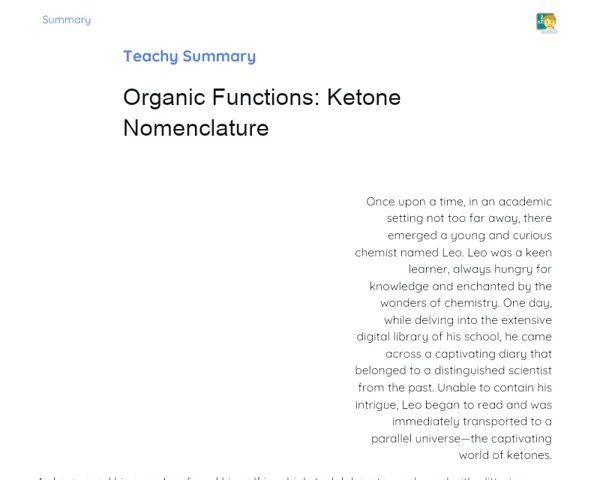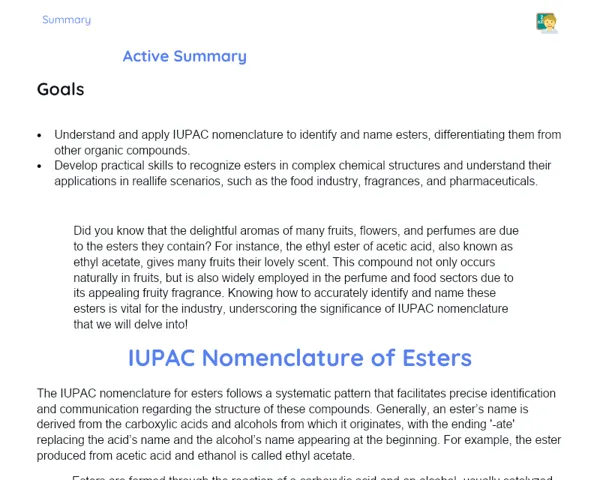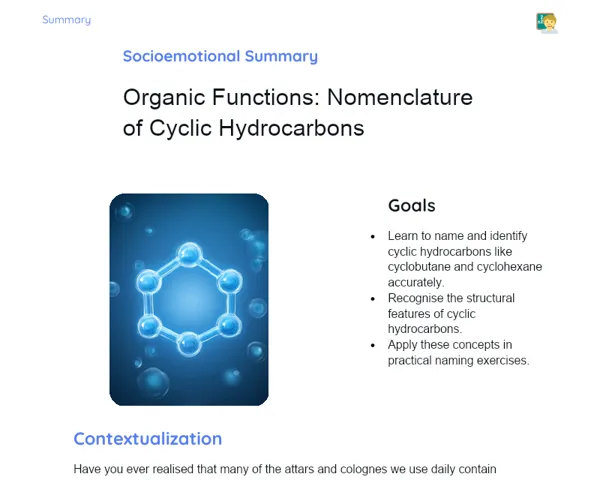Socioemotional Summary Conclusion
Goals
1. Differentiate between pi and sigma bonds and appreciate their effects on molecular properties and geometry.
2. Count and correctly identify the number of pi and sigma electrons in various organic molecules.
Contextualization
Did you know that organic chemistry is woven into the fabric of our daily lives? Whether it’s the food on our plates or the medicines we rely on, a good grasp of pi and sigma bonds can pave the way for innovations in many fields. Imagine crafting new materials with remarkable features or understanding the workings of molecules in our medications. Organic chemistry, along with its bonds, truly lies at the heart of many everyday phenomena! 🌟
Exercising Your Knowledge
Sigma Bonds (σ)
Sigma bonds arise from a direct, head-on overlap of atomic orbitals and are the strongest type of covalent bond. They play a key role in holding the basic structure of molecules together, while also allowing atoms to rotate freely around the bond axis. This ability to rotate influences the molecule’s flexibility and overall shape, which is vital in determining a compound’s physical properties.
-
Formation: Formed from a head-on overlap of atomic orbitals, sigma bonds are among the strongest bonds in a molecule.
-
Free Rotation: The sigma bond permits unimpeded rotation along the bond axis, thereby contributing to molecular flexibility.
-
Fundamental: These bonds are crucial in maintaining the stable, basic structure of molecules.
Pi Bonds (π)
Pi bonds are created by the side-on, or lateral, overlap of unhybridized p orbitals. They are typically found in molecules with double or triple bonds and, as a rule, are not as strong as sigma bonds. The presence of a pi bond limits the rotation of atoms, which has a direct impact on the molecule’s reactivity and stability. Additionally, pi bonds are key to chemical reactivity and help in the stabilization of structures through resonance, as seen in aromatic compounds like benzene.
-
Formation: Resulting from the lateral overlap of unhybridized p orbitals, pi bonds commonly occur in double and triple bonds.
-
Rotation Restriction: The pi bond curbs the possibility of atomic rotation, thus fixing the molecular conformation.
-
Reactivity: Molecules containing pi bonds, such as benzene, show distinctive reactivity and stability due to resonance effects.
Molecular Geometry and Hybridization
Hybridization—where atomic orbitals mix to form new hybrid orbitals—is a fundamental concept for understanding molecular geometry. Different forms of hybridization (sp, sp2, sp3) result in various spatial arrangements of atoms, which in turn influence the physical and chemical behaviour of molecules. For example, sp3 hybridization leads to a tetrahedral shape, while sp2 hybridization gives rise to a trigonal planar arrangement.
-
Sp3 Hybridization: Yields a tetrahedral geometry, commonly seen in molecules like methane (CH4).
-
Sp2 Hybridization: Results in a trigonal planar geometry, such as that found in ethylene (C2H4) which contains a combination of sigma and pi bonds.
-
Importance: The type of hybridization directly affects molecular reactivity and physical properties, making it a cornerstone in the study of organic chemistry.
Key Terms
-
Sigma Bonds (σ): A type of covalent bond formed through the direct overlap of atomic orbitals.
-
Pi Bonds (π): A covalent bond established by the lateral overlap of unhybridized p orbitals.
-
Hybridization: The process by which atomic orbitals combine to form new hybrid orbitals, influencing the geometric structure of molecules.
-
Molecular Geometry: The three-dimensional arrangement of atoms within a molecule, largely determined by the hybridization of central orbitals.
-
Resonance: A stabilizing phenomenon in certain molecules with pi bonds, where electrons are delocalized over a hybrid structure.
For Reflection
-
How did you feel collaborating with your group to identify pi and sigma bonds? What emotions surfaced and how did you manage them? 🌟
-
Which strategies did you use to overcome challenges encountered during this class? How might these approaches be applied to other academic or personal situations?
-
In what ways has understanding sigma and pi bonds shaped your view of everyday materials and substances? How could this influence your future academic and career choices? 🚀
Important Conclusions
-
Sigma bonds are established through the direct overlap of atomic orbitals and are stronger than pi bonds.
-
Pi bonds form via the side-on overlap of unhybridized p orbitals, limiting the rotation of atoms.
-
The hybridization of atomic orbitals gives rise to different molecular geometries, affecting the overall properties of molecules.
-
A clear understanding of sigma and pi bonds is essential to grasp the reactivity, stability, and physical characteristics of organic compounds.
Impacts on Society
Organic chemistry holds significant importance in many aspects of our daily lives. The materials we rely on, including plastics and medicines, are deeply influenced by our knowledge of sigma and pi bonds. For instance, the durability and flexibility of plastics are governed by sigma bonds, while the reactivity of several medications is shaped by pi bonds.
On an emotional note, learning about these bonds can transform the way you see the world. Think about the thrill of discovering how a new medicine is formulated or how a robust material comes into being! This insight not only expands your academic and professional horizons, but also instils a deeper appreciation for the science that underpins our everyday life. 🌟
Dealing with Emotions
When studying at home, try applying the RULER method to manage your emotions. First, recognize your feelings when you confront a challenging problem or nail a tricky question. Understand the reasons behind these emotions—be it frustration from a tough concept or the joy of a breakthrough. Label the emotions you experience, such as stressed, anxious, joyful, or relieved. Express them in a healthy manner, maybe by discussing with a friend or jotting them down in a journal. Finally, regulate your emotions through activities like deep breathing or taking a short break, keeping your focus and productivity intact. 💪🏻✨
Study Tips
-
Create mind maps connecting the ideas of sigma and pi bonds with practical examples from your day-to-day experiences.
-
Form study groups to discuss and tackle problems, making the most of shared insights and varied perspectives.
-
Utilize videos and online simulations to get a clear visual understanding of the formation and behaviour of sigma and pi bonds in different molecules.



